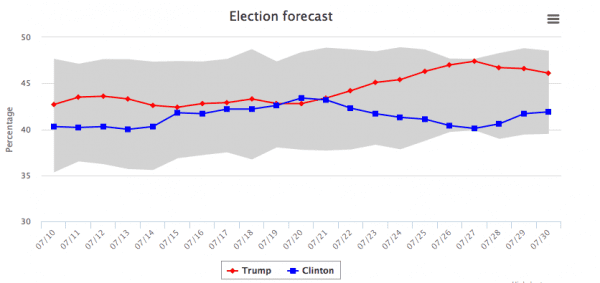NEWS YOU CAN USE: 9 Best Places to Move to for Everyone Who Vowed to Leave Country If Trump Wins. I notice that people are always threatening to move to Canada, but not Mexico.
Archive for 2016
July 31, 2016
NOT MUCH OF A BOUNCE FOR HILLARY, according to the USC Dornsife/LA Times tracking poll:

Meanwhile, Nate Silver has the chance of winning at 51% Clinton, 49% Trump.
UPDATE: That’s Silver’s PollsPlus forecast. The NowCast has Trump lagging badly, 56.8 to 43.2.
Correction, that’s the PollsOnly. PollsPlus is 60.9 and 39.1. Silver’s site doesn’t play very well with my NoScript plugin.
ANOTHER UPDATE: “Our ‘now-cast’ has flipped back toward Clinton, but long-term models haven’t really budged yet… not enough data.” Stay tuned.
NOW THAT IT LOOKS AS IF TRUMP MIGHT WIN, people are worrying about the power of the presidency.
All is proceeding as I have foreseen.
ELECTION 2016: AT LEAST NIXON IS TUNING IN.
HOW DOES A JAZZ MUSICIAN MAKE IT IN NEW YORK?: Hey, how does a jazz musician make it anywhere? The Village Voice article is a good read. Sample: “Jazz musicians invented the term gig. So you’d think they would have home-field advantage in the gig economy. It doesn’t quite work that way.” One musician quoted in the article said in Austin (Texas) “…life was easier, the cost of living cheaper, and the pay better for musicians.” I believe him.
QUESTION ASKED AND ANSWERED. Ann Althouse: Is there some reason why Hillary keeps doing this gaping-maw face?

TUNISIA FIRES ITS PRIME MINISTER: He has failed to spur economic growth. Tunisia is Arab Spring 2011’s slow success. The article mentions the political party Nidaa Tounes (Call of Tunisia). It’s the country’s largest party and it is secularist.
MAKE AMERICA GREAT AGAIN: Melania Trump like you’ve never seen her before (NSFW).
TAXPROF ROUNDUP: The IRS Scandal, Day 1179.
WOODROW WILSON COULD NOT BE REACHED FOR COMMENT. Hillary’s America: New D’Souza Film Exposes Dems’ Connection to the KKK.
FRACKING WONDERFUL: Shale Ready to Tango with the Saudis.
When oil prices first started falling two summers back, market observers turned their attention to OPEC to see if the cartel would constrain production to stop the slide. But Saudi Arabia strong-armed its fellow petrostates into staying put, reasoning that market share was more important than robust prices, and so oil fell down below $30 per barrel earlier this year before rebounding into the $40s where it remains today. Riyadh’s reasoning was based on the assumption that bargain prices would hurt upstart non-OPEC producers (read: American shale firms) more than it would hurt the big petrostates, and its strategy of inaction has been somewhat successful: U.S. oil production is down roughly one million barrels per day from a year ago.
But this dip is hardly the precipitous fall the Saudis were hoping for. Shale production is relatively expensive, but U.S. frackers have innovated their way out of a tight spot and managed to keep the oil flowing in quantities most analysts expected wouldn’t be possible in today’s price environment. But a slower-than-expected decline isn’t the only trick shale has up its sleeve, because as Reuters reports, one fracking company believes it can compete on cost with Saudi Arabia’s mega-fields. . . .
Back when prices first started to tumble, analysts believed the breakeven price for most shale projects—that is, the oil price companies would need to still turn a profit with their operations—was somewhere near $75 per barrel. Pioneer is now claiming it is operating wells that could still turn a profit with prices under $3 per barrel, putting those projects on par with the bigger conventional fields of Saudi Arabia.
This doesn’t mean that every shale well could stay online if prices suddenly plunged below $10 (Pioneer is citing its lowest cost wells in its most productive fields here), but it does evince one of the underlying strengths of the American shale boom: its ability to constantly improve, iterate, and innovate new techniques and technologies to bring costs down while boosting output. Are you ready for a shale rebound?
Yes. Starve our enemies.
I THINK IT’S WITH HER UNICORN: Clinton Should Find Her Warmer Side. Please. Soon.
AS A WISE COMMUNITY ORGANIZER ONCE SAID, GET IN THEIR FACES AND PUNCH BACK TWICE AS HARD: Milo Files Legal Claim to Get Twitter to Release Data About His Banishment from the Network.
SHOCKER: As a Teen Cashier Seeing Food Stamp Use, I Changed My Mind About the Democrat Party.
I also learned how people gamed the welfare system. They’d buy two dozen packs of soda with food stamps and then sell them at a discount for cash. They’d ring up their orders separately, buying food with food stamps, and beer, wine, and cigarettes with cash. They’d regularly go through the checkout line speaking on their cell phones. I could never understand why our lives felt like a struggle while those living off of government largesse enjoyed trinkets that I only dreamed about. . . .
Every two weeks, I’d get a small paycheck and notice the line where federal and state income taxes were deducted from my wages. At least as often, our drug-addict neighbor would buy T-bone steaks, which I was too poor to buy for myself but was forced by Uncle Sam to buy for someone else. This was my mindset when I was seventeen, and though I’m far less angry today than I was then, it was my first indication that the policies of Mamaw’s “party of the working man”—the Democrats—weren’t all they were cracked up to be.
Political scientists have spent millions of words trying to explain how Appalachia and the South went from staunchly Democratic to staunchly Republican in less than a generation.
Some blame race relations and the Democratic Party’s embrace of the civil rights movement. Others cite religious faith and the hold that social conservatism has on evangelicals in that region.
A big part of the explanation lies in the fact that many in the white working class saw precisely what I did, working at Dillman’s.
Nobody likes to feel like a sucker.
WELL, THEY CERTAINLY EARNED THE WORLD’S CONTEMPT: It’s Not Just Donald Trump and Bernie Sanders—The Whole World Is Turning On Its Elites.
DETROIT NEWS: WikiLeaks reveals DNC holds unions in contempt.
WHY BERNIE SANDERS NEVER HAD A CHANCE: “Bernie voters, you sad saps, you never had a chance. Now, we can reasonably suspect that the chance you didn’t have goes back eight years. We can also deduce that the Democratic Party is a top-down organization, not a grassroots organization. They claim to be, of course, but the power at the top has nothing to do with the will of the people in its base. It’s a club where only the opinions of a couple of members count.”
Read the whole thing.
MASSACHUSETTS: AG copycat ban spurs rifle sales: Business booms week after crackdown.
Related: Party of Science: “Cyndi Roy-Gonzalez, spokeswoman for Healey, said the office did not consider how many shootings in Massachusetts have been carried out with assault-style rifles, but insisted the ban is an effective anti-violence measure. According to FBI statistics, rifles of any variety were used in just two of the Bay State’s 779 murders in the past five years, which were mainly carried out with handguns. In that same period, hands and feet were cited as the murder weapon 35 times.”
THIS IS, SADLY, BRAVE: Top Muslim journalist announces he is converting to Christianity.
MOSBY’S FUTILE PROSECUTIONS NEARLY BANKRUPTED POLICE UNION: “Marilyn Mosby will leave quite a legacy. High police dues will be the least of it.”
VENEZUELA ENTERS THE FOURTH CIRCLE OF STATIST HELL.
Whether it’s North Korea vs. South Korea, Cuba vs. Chile, or Ukraine vs. Poland, nations with bigger governments and more intervention inevitably decline compared to market-oriented alternatives.
That’s very compelling evidence, in my humble opinion, but I wonder whether it’s not overly persuasive because it’s too dry and analytical.
Maybe I should focus more on the human cost of statism. And not just by sharing data about low levels of per-capita GDP. Perhaps it would help to explain what that means for the lives of ordinary people.
Venezuela certainly would be a perfect (in a bad way) example.
Sean Penn was unavailable for comment.
July 30, 2016
AT AMAZON, deals galore in Training & Fitness.
And shop the Amazon Emergency Prep Store. Plus, Emergency & Long-Term Storage Food Deals. When bad things happen, it’s good to have food.
Plus, Generators and Portable Power for Storm Season. Or if a generator isn’t practical, consider an inverter. Summer storms are coming!
And with all the Zika news, I’m guessing that the mosquito control stuff will be a big item this year.
THIS ISN’T THE 21st CENTURY I WAS PROMISED: Anti-Semitic SJWs Upset That Wonder Woman Role Given to Israeli Gal Gadot.
